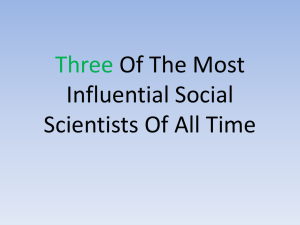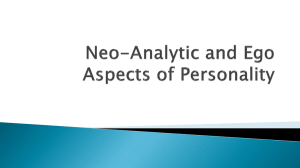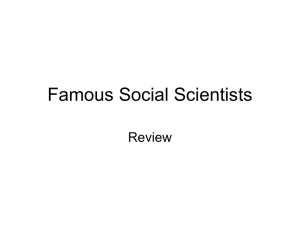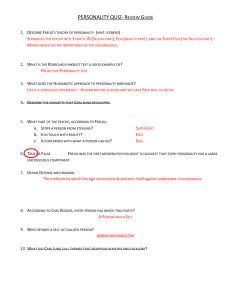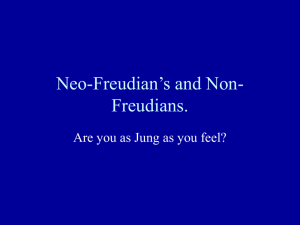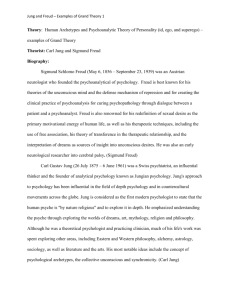FreudPsychoanalysisPersonality
advertisement
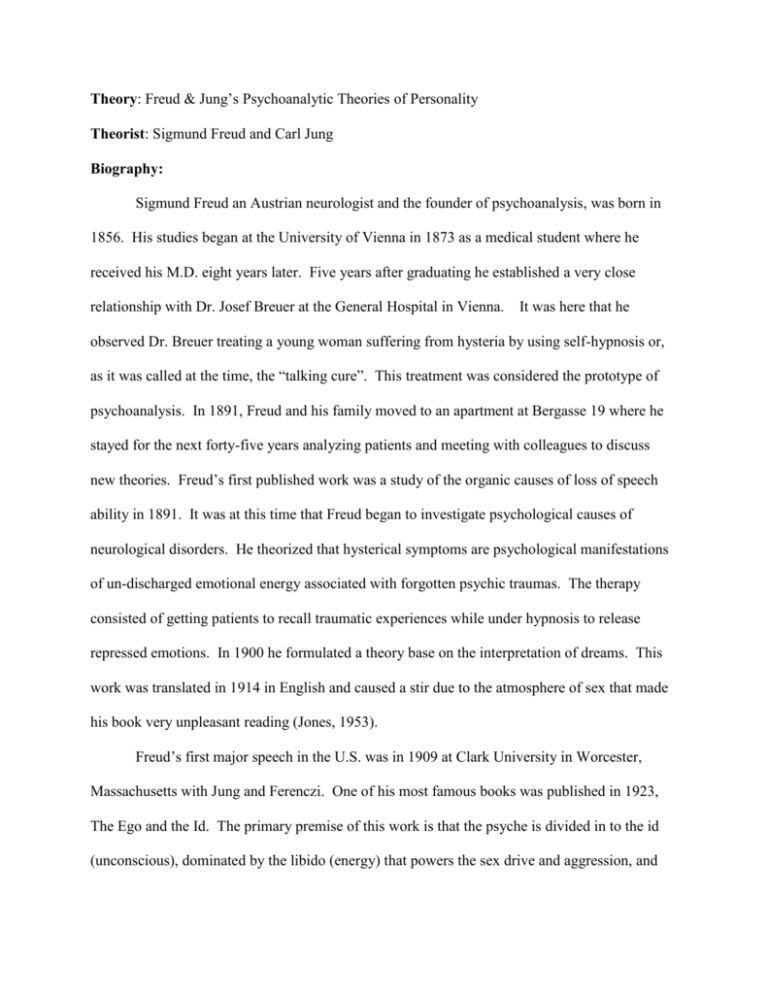
Theory: Freud & Jung’s Psychoanalytic Theories of Personality Theorist: Sigmund Freud and Carl Jung Biography: Sigmund Freud an Austrian neurologist and the founder of psychoanalysis, was born in 1856. His studies began at the University of Vienna in 1873 as a medical student where he received his M.D. eight years later. Five years after graduating he established a very close relationship with Dr. Josef Breuer at the General Hospital in Vienna. It was here that he observed Dr. Breuer treating a young woman suffering from hysteria by using self-hypnosis or, as it was called at the time, the “talking cure”. This treatment was considered the prototype of psychoanalysis. In 1891, Freud and his family moved to an apartment at Bergasse 19 where he stayed for the next forty-five years analyzing patients and meeting with colleagues to discuss new theories. Freud’s first published work was a study of the organic causes of loss of speech ability in 1891. It was at this time that Freud began to investigate psychological causes of neurological disorders. He theorized that hysterical symptoms are psychological manifestations of un-discharged emotional energy associated with forgotten psychic traumas. The therapy consisted of getting patients to recall traumatic experiences while under hypnosis to release repressed emotions. In 1900 he formulated a theory base on the interpretation of dreams. This work was translated in 1914 in English and caused a stir due to the atmosphere of sex that made his book very unpleasant reading (Jones, 1953). Freud’s first major speech in the U.S. was in 1909 at Clark University in Worcester, Massachusetts with Jung and Ferenczi. One of his most famous books was published in 1923, The Ego and the Id. The primary premise of this work is that the psyche is divided in to the id (unconscious), dominated by the libido (energy) that powers the sex drive and aggression, and the ego (conscious), which mediates between these drives and external reality (superego). During the last decade of his life, he developed jaw cancer and his strength waned. He and his family left Austria before the war and settled in London in 1938 and it was there that he died in 1939 (Jones, 1953). Carl Gustav Jung was born in Switzerland in 1875 and is widely regarded as the founder of analytical psychology. He obtained his medical degree from the Universitat Basel in 1900. In 1911, Jung founded The International Psychoanalytic Society focused on psychological interpretation of the mythological elements in dream and fantasy. It was here that Jung recognized in symbolic language, dreams, and the arts communicate truths known to the unconscious mind. During World War I, he served as a medical officer in the Swiss Army and was in charge of British prisoners of war. He further honed his collective unconscious theory when in 1921, he observed natives in North Africa and again in Arizona and New Mexico in 1924 and 1925. In 1948 the C.G. Jung Institute Zurich was opened with a mission to carry on research in analytical psychology and training of Jungian analyst. In later years until his death in 1961, he enjoyed walking his native mountains, yachting and swimming in Lake of Zurich (Bair, 2003). Freud’s Theory Description: Freud used psychoanalysis to provide insight into thoughts and actions by exposing and interrupting the underlying unconscious motives and conflicts of an individual (Blair-Broeker, Ernst, & Myers, 2008, pp. 325-326). In order to gain insights, Freud often experimented with hypnosis, but he found that this method did not work for all patients. It was because of this, he began to ask his patients to enter a state of relaxation and say whatever came to mind, a technique he called free association. Freud believed this was the window into the unconscious mind (Blair-Broeker, et al., 2008, pp. 325-326). Freud’s Conscious, Preconscious, and Unconscious Mind Freud compared the human mind to an iceberg consisting of three regions: the conscious, preconscious, and unconscious. Figure 1 demonstrates the association of above and below sea level to the three regions of the mind. Freud believed that most of the mind was hidden from view. The conscious mind was the thoughts and feelings we are fully aware of, the part of the iceberg above sea level. Just below sea level is the preconscious, a region of the mind that Freud believed held information that is not in the conscious mind but is still retrievable (Blair-Broeker, et al., 2008, pp. 325-326). At the deepest level below the water line, is the region of the mind that Freud termed the unconscious, a region that holds mostly unacceptable thoughts, wishes, feelings, and memories. Freud believed this region of the mind held painful childhood memories and if opened, could allow a “healing” treatment to occur (Blair-Broeker, et al., 2008, pp. 325326). It was through free association and dream analysis techniques that Freud attempted to catch glimpses at the unconscious mind of patients with psychological disorders. Freud’s The Id, the Superego, and the Ego Also illustrates in Figure 1 is Freud’s three parts of personality: the id, the superego, and the ego (Blair-Broeker, et al., 2008, pp. 325-326). Freud believed the id consists of sexual and aggressive drives, demanding immediate gratification (Blair-Broeker, et al., 2008, pp. 325-326). The superego consists of the internalized ideas and leads an individual’s moral judgments (the conscious mind) (Blair-Broeker, et al., 2008, pp. 325-326). The superego will develop as a child interacts with parents, peers, and society in general, striving for perfection. Freud believed those with a weak superego were individuals who gave into their urges and impulses with disregard for the rules or moral judgment (Blair-Broeker, et al., 2008, pp. 325-326). The ego mediates the demands of the id, superego, and reality. The purpose of the ego is to make decisions after listening to both the demands of the id and the judgment of the superego. The ego satisfies the id’s desires in ways that will realistically bring pleasure rather than pain. Freud believed the ego represented a good sense and reason (Blair-Broeker, et al., 2008, pp. 325-326). Freud believed that a healthy personality was one that was able to successfully express pleasure-seeking impulses while being able to avoid the feeling of guilt. To achieve this healthy balance, the ego often must utilizes defense tactics (Blair-Broeker, et al., 2008). Freud’s Defense Mechanisms Freud believed that anxiety was a price that we must all pay in order to live in a civilized society. The conflict between the id’s wishes and the superego’s social rules is what produces feeling of anxiety; however, Freud believed that the ego has an arsenal of unconscious defense mechanisms (Blair-Broeker, et al., 2008, p. 327). There are several defense mechanisms; however, this paper will focus on only seven: repression, regression, denial, reaction formation, projection, rationalization, and displacement(Blair-Broeker, et al., 2008, p. 327). Repression “banishes” anxiety-arousing thoughts, feelings, and memories from the conscious mind. Freud believed that repression was the basis for all other anxiety-reducing defense mechanisms. Regression allows the anxious person to retreat to a more comfortable, infantile stage of life. Denial lets the anxious person refuse to admit that something unpleasant is happening, while reaction formation reverses an unacceptable impulse, causing an anxious person to feel opposite. Projection disguises the threatening feelings of guilty anxiety by attributing the problem to others. A key example given by Blair-Broeker, el al. is Hamlet, “The lady doth protest too much.” In other words, the guilty one often finds blame in everyone but themselves. Rationalization displaces anxiety-provoking explanations with more comfortable justifications for actions. This makes mistakes seem reasonable and often sounds like an excuse. Displacement shifts an unacceptable impulse toward a more acceptable or less threatening object or person. An example of this defense mechanism is the chain of command in a crisis situation. The owner of a business becomes frustrated or mad and takes it out on the manager, who then yells at employees, who then takes it out on their families (Blair-Broeker, et al., 2008, p. 327). Freud’s Neurosis and Psychosis A neurosis represents an instance where the ego's efforts to deal with its desires through defense mechanisms such as repression or displacement fails (Felluga, 2011; Freud, 1953-74). Freud believed this conflict of the ego and the id allowed the mind to experience pleasure in an alternate method (Felluga, 2011; Freud, 1953-74). This substitutes for the instinctual impulse with something that is so reduced, displaced, and distorted that it is often not recognizable as a gratification but looks more like a compulsion or even an illness, resulting in neurosis. Someone who experiences neurosis simply has more of these alternate impulse substitutions, referred to as symptoms, that prevent enjoyment and active achievement in life (Felluga, 2011; Freud, 195374). In contrast, a psychosis refers to a patient who has completely lost touch with reality. Freud originally distinguished between neurosis and psychosis in that neurosis allowed the ego to suppress part of the id from reality, while the psychosis lets itself be carried away by the id and detached from reality (Felluga, 2011; Freud, 1953-74). Freud’s Psychosexual Stages of Development Through research and experimental analysis, Freud concluded that personality forms during the first 5 or 6 years of life. He believed that an individual’s problems originated in conflicts that were not resolved during these stages of development. The psychosexual stages of development identified by Freud are oral, anal, phallic, latency, and genital in which he concluded the id’s pleasure-seeking energies focus on different parts of the body (Blair-Broeker, et al., 2008, p. 328). Table 1 illustrates the differences among each stage. Jung Theory Description: Carl G. Jung, considered a great thinker of his time, expanded on the Freudian approach to psychoanalytic theories of personality by defining his own perspective called analytical psychology (Sahakian, 1977, p. 48). The framework and sexual undertones of Freud’s thinking was too limiting for Jung, who wanted to expand his own theories on learning and the aspects of self (Soylent Communications, 2011). Even though Carl Jung was Freud’s colleague and friend, their relationship was severed over the publication of Jung’s renowned work about symbols, which departed from the Freudian approach (Jadot, 1984). While Freud’s work was fixated on the biological human, Jung’s work concentrated more on the reflective self or inner human (Soylent Communications, 2011). Jung contended that everyone has the accumulation of previous generations stored in their unconscious as a “collective” along with individual unconscious which is based on actual lived experience (Sahakian, 1977, p. 53). Sahakian (1977) described the collective unconscious as being “made up essentially of archetypes” (p. 54). Archetypes, according to Vernon (2011) “are elementary ideas, feelings, fantasies and visions that seem constant and frequently reemerge across different times and places” (p.48). These archetypes are also described as symbols (Pervin, 1980). Jung’s theory suggests that both types of unconscious (individual and collective) exist in everyone, playing an important part of their psychological makeup (Sahakian, 1977). Jungian psychology also describes conditions where there are contrasting or conflicting forces within people which should be balanced. The face or “persona” presented in public may be different from the actual private person (Pervin, 1980, p. 88) and is only “the tip of the iceberg” (Soylent Communications, 2011, p. 4). According to Jung, finding individual equilibrium or balance between these opposing personalities is an important step toward knowing one self. Striving for balance in life should be everyone’s objective, even though perfect equilibrium according to Jung may not be possible (Pervin, 1980). Jung contended that everyone possesses several opposing traits such as feminine and masculine personality traits and introverted and extraverted personality types (Pervin, 1980). These multiple personality traits usually exhibit themselves outwardly as the stronger individual trait when in public. Engaging in activities that match the stronger individual personality trait produces individual energy (Vernon, 2011). Jung considered striving for and achieving equilibrium or balance as a life-long endeavor (Pervin, 1980). This life-long balancing act Jung considered very important for people over forty, as an imbalance could lead to a mid-life crisis (Vernon, 2011; Pervin, 1980). Jung was describing his interpretation of the need for consciousness of self (Vernon, 2011). Interest in human development extended well beyond youth for Jung, which was different than Freud’s focus. Assuming a person is successful in maneuvering through Jung’s description of mid-life, they should become content individuals with the benefit of age, wisdom, and energy on their side (Vernon, 2011). This theory is evident today in the baby-boomer generation as they actively engage in the milieu of society redefining perceptions about old-age (Vernon, 2011). Educators especially need to be “well-adjusted” people, with well-rounded educational preparedness, to avoiding imprinting children with their own personal malcontent (Ewen, 1988, p.114). Jung encouraged continuing education or life-long learning for everyone, stressing the importance especially for educators (Ewen, 1988, p.114). He was also concerned with the need for teachers to “have some understanding of the common varieties of childhood psychopathology” (Jung, as cited in Ewen, 1988, p.114). Teachers should pay close attention to the educational needs of the introverted child as well as being prepared to meet the demands of teaching gifted children, without over emphasizing either child’s abilities (Ewen, 1988). Jung advocated for teachers to create an interactive learning environment such that any child could “explore the inner world of their own psyche” (Ewen, 1988, p.114). Measurement Jung’s theory on personality traits was first implemented in an instrument developed by Grey-Wheelwrights, then expanded by mother and daughter team of Katherine Briggs and Isabel Meyers (Wilde, 2011). Meyers and Briggs added to the existing Jung variables, resulting in the popular measurement instrument widely known as the Myers-Briggs type indicator (MBTI). The MBTI is a personality oriented test and measurement instrument based on C.G. Jung’s clinical work which has the ability to identify the individual personality types or traits (Wilde, 2011; Vernon, 2011). This instrument is frequently use in work environments to identify and then match up team members with certain combinations of personality traits. Popularity of the MBTI instrument continues today with millions of copies sold on an annual basis (Vernon, 2011). Prepared By: Brittany Bright, Robert Dionne, and Tony Smith References Bair, D. (2003). Jung: A Biography. New York, NY: Back Bay Books Blair-Broeker, C. T., Ernst, R. M., & Myers, D. G. (2008). Thinking About Psychology: The Science of Mind and Behavior. New York: Worth Publishers. Ewen, R. B. (1988). An introduction to theories of personality. Hillsdale, N.J: Lawrence Erlbaum Associates, Publishers. Felluga, D. (2011, January 31). "Modules on Freud" Retrieved November 6, 2011, from http://www.purdue.edu/guidetotheory/psychoanalysis/freud4.html Freud, S. (1953-74). The Standard Edition of the Complete Psychological Works of Sigmund Freud Trans. James Strachey. London: Hogarth. Jadot, L. (1984). From the symbol in psychoanalysis to the anthropology of the imaginary. in R. K. Papadopoulos, & G. S. Saayman, (eds.), Jung in modern perspective (pp. 109-119). Middlesex, Great Britain: Wildwood House Ltd. Jones, E. (1953-1957). The Life and Work of Sigmund Freud. 3 vols. New York, NY: Basic Books Pervin, L. A. (1980). Personality: Theory, assessment, and research. New York: Wiley. Soylent Communications. (2011). Carl Jung. [NNDB, tracking the entire world]. Retrieved from: http://www.nndb.com/people/910/000031817/ Vernon, M. (2011). Why Jung still matters. Management Today, 46-50. Retrieved from EBSCOhost. Wilde, D. J. (2011). Jung’s personality theory quantified. doi: 10.1007/978-0-85729-100-4_1. Table 1 Freud’s Psychosexual Stages of Personality Development Stage Oral Ages Focus of Libido Major Development 0-18 months Mouth, Tongue Lips Weaning of breast feeding or formula Anal 18 months-3 years Anus Potty training Phallic 3 to 6 years Genitals Resolving Oedipus/Electra Complex None Develop defense mechanisms & Latency 6 years-Puberty begin “identification process” Genital Puberty+ Genitals Sexual Maturity Note. Adapted from Blair-Broeker, C. T., Ernst, R. M., & Myers, D. G. (2008). Thinking About Psychology: The Science of Mind and Behavior. New York: Worth Publishers and Garcia, J. L. (1995). Freud's Psychosexual Stage Conception: A Developmental Metaphor for Counselors. [Article]. Journal of Counseling & Development, 73(5), 498-502. Figure 1. Freud’s Iceberg Theory. Adapted from Blair-Broeker, C. T., Ernst, R. M., & Myers, D. G. (2008). Thinking About Psychology: The Science of Mind and Behavior. New York: Worth Publishers.

